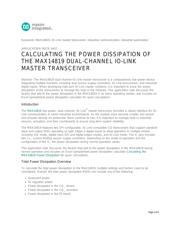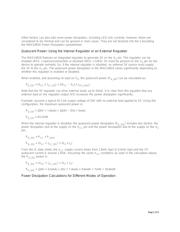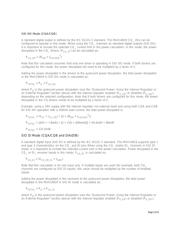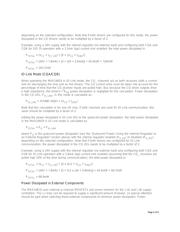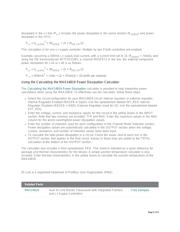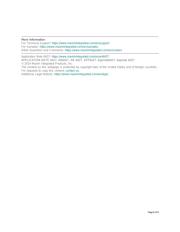下载

Keywords:
MAX14819, IO-Link master transceiver, industrial communication, industrial automation
APPLICATION NOTE 6427
CALCULATING THE POWER DISSIPATION OF
THE MAX14819 DUAL-CHANNEL IO-LINK
MASTER TRANSCEIVER
Abstract: The MAX14819 dual-channel IO-Link master transceiver is a comparatively low-power device
integrating multiple functions including dual sensor-supply controllers, IO-Link transceivers, and industrial
digital inputs. When developing high-port IO-Link master solutions, it is important to know the power
dissipation of the transceivers to manage the heat in the modules. This application note discusses the
factors that add to the power dissipation in the MAX14819 in its many operating modes, and includes an
Excel spreadsheet power dissipation calculator for quick calculations.
Introduction
The
MAX14819 low-power, dual-channel, IO-Link master transceiver provides a robust interface for IO-
Link communication in harsh industrial environments. As the module sizes become smaller and sensor
and actuator density on production floors continue to rise, it is important to manage heat in industrial
sensors, actuators, and their counterparts to ensure long-term system reliability.
The MAX14819 features two SPI-configurable, IO-Link-compatible CQ transceivers that support standard
input and output (SIO) operating as type 1/type 3 digital inputs to allow operation in multiple modes,
including SIO mode, digital input (DI) and digital output modes, and IO-Link mode. The IC also includes
two L+_ current-limiting sensor supply controllers. Depending on the mode of operation and the
configuration of the IC, the power dissipation during normal operation varies.
This application note discusses the factors that add to the power dissipation in the MAX14819 during
normal operation and includes an Excel spreadsheet power dissipation calculator
Calculating the
MAX14819 Power Dissipation
for quick calculations.
Total Power Dissipation Overview
To calculate the total power dissipation in the MAX14819, multiple settings and factors need to be
considered. Overall, the total power dissipated (PDIS) can include any of the following:
Quiescent power
5V regulator power
Power dissipated in the CQ_ drivers
Power dissipated in the CQ_ receivers
Power dissipated in the DI inputs
®
Page 1 of 6


